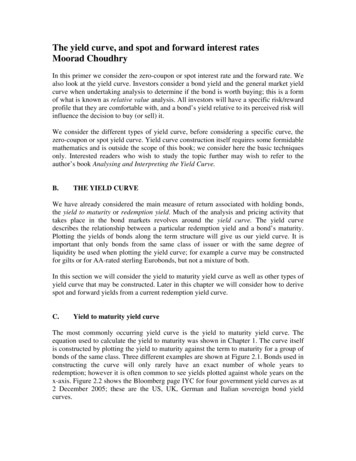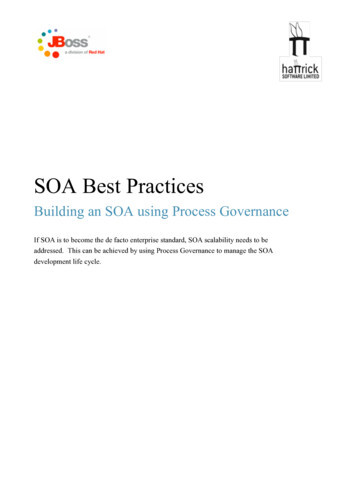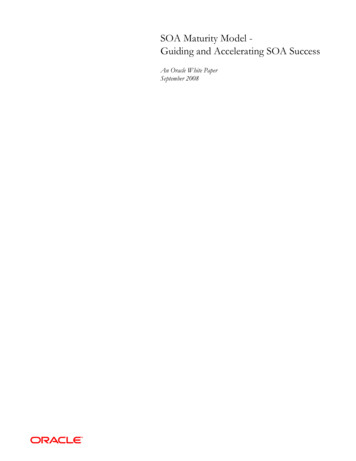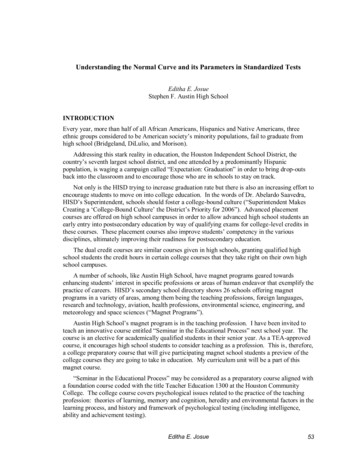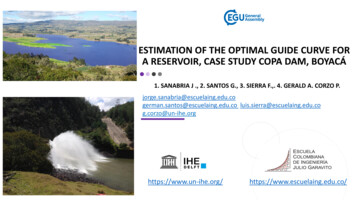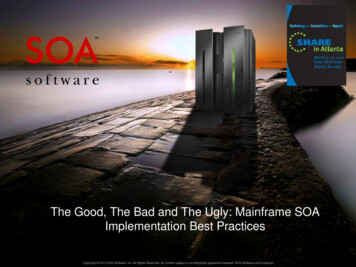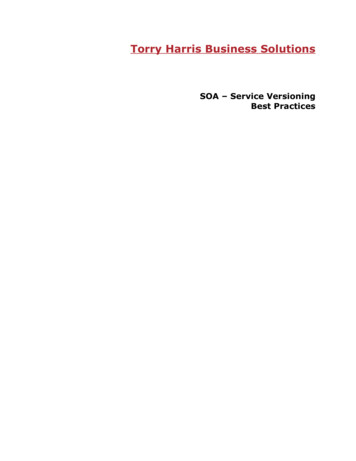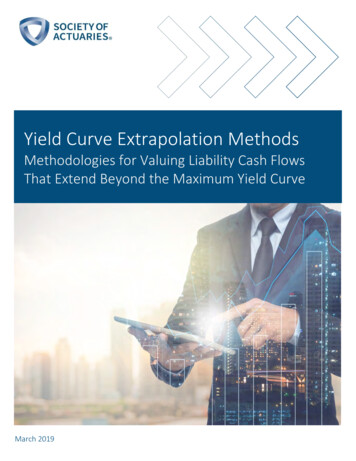
Transcription
Yield Curve Extrapolation MethodsMethodologies for Valuing Liability Cash FlowsThat Extend Beyond the Maximum Yield CurveMarch 2019
2Yield Curve Extrapolation MethodsMethodologies for Valuing Cash Flows That Extend Beyond theMaximum Yield CurveAUTHORSKemi Akinyemi, FSA, EA, MAAAActuarial ConsultantRisk & Regulatory ConsultingSPONSORSociety of Actuaries Committee onFinance ResearchJack Kerbeshian, FSA, MAAAActuarial ConsultantRisk & Regulatory ConsultingBenjamin Leiser, FSA, MAAAConsulting ActuaryRisk & Regulatory ConsultingPatricia Matson, FSA, MAAAPartnerRisk & Regulatory ConsultingCaveat and DisclaimerThe opinions expressed and conclusions reached by the authors are their own and do not represent any official position or opinion of the Society ofActuaries or its members. The Society of Actuaries makes no representation or warranty to the accuracy of the informationCopyright 2019 by the Society of Actuaries. All rights reserved.Copyright 2019 Society of Actuaries
3CONTENTSExecutive Summary . 4Section 1: Introduction . 6Section 2: Methodology . 82.1 Initial Research . 82.2 Questionnaire and Interviews. 82.3 Panelists’ Backgrounds . 92.4 Summary of Research and Results of Questionnaire . 9Section 3: Summary of Research Results . 103.1 Philosophical Considerations: Market Consistency/Liability Stability . 103.2 Extrapolation and the Ultimate Long-Term Forward Rate . 113.3 Sample of Extrapolation Methods . 123.4 Comparing the Nelson-Siegel, Svensson and Smith-Wilson Methods . 173.5 Smith-Wilson Model . 183.6 Panelist Views on Practical Applications . 203.7 Panelist Views on Mechanics . 223.8 Panelist Views on Complexity . 233.9 Panelist Views on Hedgeability . 233.10 Panelist Views on Software Selection . 243.11 Panelist Views on Governance and Responsibilities. 243.12 Additional Panelist Comments. 25Section 4: Concluding Remarks . 27Section 5: Expert Panelists . 28Section 6: Acknowledgments . 29References . 30Appendix A: Questionnaire . 31Appendix B: Definitions . 34About The Society of Actuaries . 35Copyright 2019 Society of Actuaries
4Yield Curve Extrapolation MethodsMethodologies for Valuing Cash Flows That Extend Beyond theMaximum Yield CurveExecutive SummaryThe Society of Actuaries Committee on Finance Research engaged Risk & Regulatory Consulting LLC (RRC) toconduct research on methodologies used for yield curve extrapolation to value liability cash flows that extendbeyond the maximum observable portion of the yield curve.The researchers performed research on the methods available in theory and used in practice andsummarized that information within this report. They also developed and provided questionnaires to variousexperts within the industry to comment on methods used to extrapolate the yield curve both in practice andin theory, and they consolidated the results of the independent research and the findings obtained from theverbal and written responses to the questionnaires to provide a comprehensive view of the yield curveextrapolation methods.There are two philosophical approaches to yield curve extrapolation: one that emphasizes marketconsistency at a point in time, and another that emphasizes liability stability across time. The advantages anddisadvantages of each approach are explored in this report.The initial goal when extrapolating the yield curve under many methods is to determine an ultimate longterm forward rate (Definitions) (UFR) to which the observable yield curve will converge.Some of the simpler extrapolation models include the Simple Monopole or Dipole methods, the Flat Rateextrapolation method and the Linear First-Order (Definitions) extrapolation method, along with a few otherfirst-order extrapolation methods. The more complex models include the Nelson-Siegel/Svennson, SmithWilson, Cairns and Cubic Spline methods. The benefits and drawbacks of these methods are covered in thereport.This report compares the Nelson-Siegel, Svennson and Smith-Wilson methods in particular and providesexpert panelist opinions on extrapolation methods. This includes industry approaches, methods they use,determining the UFR, duration of UFR, speed of convergence to the UFR, shape and smoothness of transitionfrom observed rates to the extrapolated rate, mechanics or processes used to fit the curve, complexity ofmodels and selection of software.Based on the research, it appears that most of the methods that are analyzed in theoretical discussion aresimilar to what practitioners use. Although the assumptions that feed into an extrapolation method oftenhave a greater impact than the technical methodology itself, the choice of the method does have an impacton the results. For example, using the current year forward rate extrapolated out into the future will have amuch different result than a method that grades over time.Many of the panelists stated that their method is simple and adequate. They believe that other methodsinvolve more complex math without much evidence that they are actually any more theoretically justifiable.A simple approach might be used because the liabilities involve nonguaranteed elements, which minimizesthe effect of any choice of approach as long as minimum guarantees are not in the money. Others prefer aCopyright 2019 Society of Actuaries
5complex method, perhaps using a Cubic Spline Nelson-Siegel method that is at the more sophisticated endof the spectrum. Although they may have investigated many other techniques, they could believe this is thebest solution given their requirements for highly accurate fits and an automated production process. Onepanelist stated they endeavor to use the simplest model possible, but no simpler than what is necessary tobe consistent with the market and economic principles. Simplicity is not necessarily dependent on the fittingof the model.Copyright 2019 Society of Actuaries
6Section 1: IntroductionThe Society of Actuaries (SOA) Committee on Finance Research sponsored this research study (hereafter“the Study”) to investigate yield curve extrapolation methods used to value cash flows that extend beyondthe last liquid point of a yield curve. The researchers carried out the main objectives of this project, includingbackground research, interviewing experts and developing this report. The objectives of the Study were todo the following:1.2.3.4.Perform research regarding current industry methods and approaches for extrapolation of the yieldcurve beyond the current investible universe, including details of how they are applied, and include anyobservations we have on the benefits and drawbacks and prevalence of their use. The primary focus ofthe research is on the U.S. and Canada; however, other international methodologies and guidancearound extrapolating the yield curve will also be reviewed to the extent they are directly applicable tothe U.S. and Canada.Identify and interview a broad group of subject matter experts with strong industry representation toavoid any bias in the results.Supplement the research with results of the interviews, including any theoretical and practical issuesnoted with methods. Responses will likely be too varied to draw strong conclusions from the interviewsalone because yield curve extrapolation methods are not at the point of a significant convergence ofpractice.Summarize the results of the research and interviews, including the approach, the information gatheredand the conclusions generated. The summary includes the following: A description of the methods used in the U.S. and Canadian insurance industriesAdditional commentary on methods used in certain significant regulatory regimesCommentary on the applicability of the methods beyond the insurance industry,specifically with respect to valuation of pension and other postretirement benefitsBenefits and drawbacks for each of the approaches, both practical and theoreticalOther considerations for U.S. and Canadian actuaries trying to implement an approach forvaluing insurance and pension liabilitiesBased on the results of the research, we have summarized the approach, information gathered andconclusions. The summary includes information that is responsive to each of the objectives outlined above.Risk & Regulatory Consulting (RRC) conducted this research. Information regarding RRC can be found on theirwebsite, www.riskreg.com .One of the most fundamental concepts in actuarial practice is the time value of money. For any work in whichfuture cash flows are allowed for, such as reserving or pricing, it is natural to discount to present values sothat an appropriate amount of money can be set aside today, allowing for future investment returns.Risk-free yield curves are the basic building blocks for the valuation of future financial claims and long-termrisk management work. Despite their fundamental importance, it turns out that measuring and estimatingsuitable risk-free interest rates present major challenges. In highly developed fixed-income markets, we maybe able to observe bonds or interest rate swap contracts with maturities of up to 50 years. In less developedmarkets, liquid bond quotations might be limited to only a few years. In exceptional circumstances, theremay be no traded risk-free instruments at all. Of course, the liabilities of long-term financial institutionsfrequently extend beyond the term of available market instruments. To value these long-term claims andassess risk, practitioners must extrapolate yield curves to generate a set of “prices” for the assumed, inferredprices of discount bonds beyond the term of the longest available traded cash flow. A good yield curveCopyright 2019 Society of Actuaries
7estimation method must deliver extrapolated curves that are credible at a single point in time and wherechanges over time in extrapolated rates can be justified.Yield curve construction work requires completing two fundamental tasks: first, collating market data andfitting a continuous curve to the term of the longest available market instrument, and, second, extrapolatingfrom the longest available market data toward some long-term assumption for forward interest rates.Extrapolation also requires answering two questions about the path of forward interest rates beyond thelongest market data point: First, what is an appropriate assumption for the infinite-maturity, unconditional forward rate ofinterest?Second, what path is chosen between the longest (smoothed) market forward rate and this longterm rate? In particular, the analyst needs to determine the speed at which the extrapolatedforward rate tends toward the long-term asymptote.The documentation below outlines a summary of the yield curve extrapolation methods, with additionalcommentary provided by the subject matter experts. We performed a search of commonly used yield curveextrapolation methods based on various research papers. The concept of yield curve extrapolation wassimilar across various documents, and we give a summary of this analysis.In extrapolating the yield curve beyond the current investable universe, several considerations are important,including market consistency at a point in time, liability stability across time and the smoothness of theextrapolated curve.Copyright 2019 Society of Actuaries
8Section 2: Methodology2.1 Initial ResearchThe researchers conducted an initial review of the existing literature regarding industry approaches forextrapolation of the yield curve, considering the purpose of the measurement, which is to value liability cashflows that extend beyond the maximum yield curve. The researchers reviewed several research documentscovering current approaches used in both the U.S. and Canada, as well as international approaches asapplicable. The papers and research documents used for this purpose are included in the References of thisreport.2.2 Questionnaire and InterviewsThe researchers developed an interview questionnaire based on conducting an initial review of the literatureand on additional questions to obtain related information from subject matter experts. The questionnairecovered topics such as the following: Discussion of industry approaches for extrapolating the yield curve and the situations (specificproducts, specific applications) in which each is usedKey assumptions and mechanics considered in the extrapolation of the yield curveBenefits and drawbacks of the various approachesPractical challenges that arise from various methodsRegulatory approaches for extrapolation, including the rationale for the choice(s)Governance and standards of practiceTwelve subject matter experts were interviewed, and, although several experts opted for a written response,live interviews were also conducted to discuss the questionnaire or commentaries to the questionnaire.The subject matter experts who were interviewed had one or more of the following characteristics: Practical experience in extrapolating the yield curve for purposes of valuing long-term liabilities (forexample, for purposes of internal capital calculations) across a range of life, annuity, health,property and casualty and pension liabilitiesExperience in the development and use of economic scenario generators used to value long-terminsurance liabilitiesBackground in quantitative financeExperience researching and developing theoretical methodologies for extrapolation of the yieldcurveExperience developing and/or implementing regulatory requirements that involve yield curveextrapolation (such as Solvency II)Experience in a range of jurisdictions, including the U.S., Canada and AustraliaBackground that encompasses a broad number and type of companies, to get a broad andrepresentative understanding of approaches used in the U.S. and Canada today.The panelists provided their opinions relating to the extrapolation of the yield curve beyond the investableuniverse by responding to multiple questions within the questionnaire in writing, verbally or both. Theresearchers then consolidated all questionnaire responses. Since the sample size was small, and thequestions were open-ended, the responses were not conducive to present a distribution of results.Copyright 2019 Society of Actuaries
92.3 Panelists’ BackgroundsThe panelists’ backgrounds included both theoretical and practical experience, with more than half thepanelists having both. Many have used a range of yield curve construction and extrapolation techniques overmany years. These panelists have also published many papers on the topic.All of our panelists have experience, including the development and use of economic scenario generators(ESGs). This includes experience building generators and using various ESGs and yield curves in valuation,pricing and own risk solvency assessment work. The panelists have also often supervised the use of numerousgenerators, including both proprietary and industry standard. One panelist manages a market-leading ESGwith a large worldwide customer base. This customer base spans a range of industries, liability types andregulatory regimes. Yield curve construction is a key input into the ESG calibration for all their ESG clients.The range of liability categories applied using the extrapolation of the yield curve is wide. This includes lifeinsurance, annuities, long-term care, guaranteed investment contracts, group annuities, property andcasualty (which includes some long-term portfolios such as workers’ compensation, lifetime care andmortgage insurance), pension and health.The panelists’ experience includes developing and/or implementing regulatory requirements that involveyield curve extrapolation. Some have been members of committees that have set professional standards formodel calibration. Other experience includes the following: Working with a participating company in the International Association of Insurance Supervisors(IAIS) field test of the proposed international capital standardProducing yield curves on multiple bases, including prescribed methodologies such as Solvency IIand the Swiss Solvency TestProducing papers on yield curve construction and actively participating in the insurance industry’slobbying efforts in the Solvency II consultationsProducing balance sheet reserve estimates often requiring market-consistent risk-free rates, whichinvolves a judgment on risk curve extrapolationImplementing requirements, namely, supervising the modification and use of rate models based onthe American Academy of Actuaries’ generator and VM-20 (Requirements for Principle-BasedReserves for Life Products) requirements.2.4 Summary of Research and Results of QuestionnaireThe researchers summarized the research and enhanced the results of the research based on the subjectmatter experts’ written and verbal responses to the questionnaires.Copyright 2019 Society of Actuaries
10Section 3: Summary of Research Results3.1 Philosophical Considerations: Market Consistency/Liability StabilityBroadly speaking, there are two philosophical approaches to yield curve extrapolation: one that emphasizesmarket consistency at a point in time, and another that emphasizes liability stability across time.With the market consistency approach, the aim of yield curve extrapolation is to estimate what the marketprice of longer-term assets would have been on a particular day if those assets actually existed and weretraded in the financial markets. The emphasis here is on producing a liability value that is equivalent to thevalue that would be required to transfer that liability in current market conditions.On the other hand, those adopting an approach emphasizing liability stability believe that the volatilityintroduced by requiring market consistent prices at a point in time is unhelpful for running a business overmany years. They also believe that since insurance liabilities are rarely traded, the idea of identifying marketvalue is less relevant. Some proponents of this view may be supportive of the idea of valuing liabilities forwhich hedging instruments are available with reference to the prices of those instruments. However, wherethose instruments do not exist, or are not sufficiently liquid, they would rather emphasize liability stabilityover market consistency.Each approach has its advantages and disadvantages. Although an approach that emphasizes liability stabilitymay be superficially attractive, some believe it may cause insurers to underestimate the true economic costof writing long-term insurance contracts. It would not be in the firm’s, policyholders’ or shareholders’ futureinterests if long-term contracts were issued too cheaply. In addition, an artificially stabilized liability valuationmay also make it harder to hedge balance sheet risk over the longer term.On the other hand, it has been suggested as part of the Solvency II debate that emphasizing market priceconsistency may play a role in magnifying economic or financial downturns, or, in other words, it may add topro-cyclicality. The Solvency II liability evaluation is a fair value approach, which seeks to capture changes inasset and liability values over time. It is an amount at which an asset could be exchanged betweenknowledgeable and willing parties in an arm’s-length transaction.Table 1 breaks down some differences between market-consistent (risk-neutral) and liability-stability (realworld) scenarios.Table 1Differences between Risk-Neutral and Real-World ScenariosViewPresumptionAsset returnMethodPhilosophyDataRisk-Neutral ScenariosForward lookingHistory is irrelevantRisk-free rateObjective mechanicalHard to beat marketSnapshot of current marketReal-World ScenariosBackward lookingHistory will repeatRisk rate plus risk premiumSubjective explicit judgmentCan beat marketHistorical market dataCopyright 2019 Society of Actuaries
113.2 Extrapolation and the Ultimate Long-Term Forward RateThe Initial goal when extrapolating the yield curve under many methods is to determine an ultimate longterm forward rate (UFR) to which the observable yield curve will converge. The components of the UFR arethe following (a b c-d):a.b.c.Expected future inflationExpected real short-term rate, which is the expected nominal short-term rate minus theexpected future inflationTerm premia are the additional return an investor may expect as compensation for thelonger-term investment and is the difference between the forward rate and the expectedfuture short-term interest rate. The term premium acts as compensation for holding longterm bonds, whose value will fluctuate in the face of interest rate uncertainty, exposingthe holder to mark to market losses. Term premia have the following components:i.ii.d.Risk premia—investors demand a premium for locking in long-term investments.This acts as compensation for holding long-term bonds, whose value will fluctuatein the face of interest rate uncertainty, exposing the holder to mark to marketlosses.Term preference—demand for long-term government securities from largeinstitutional investors can drive down long-term forward rates because the longterm bonds offer a closer match to liabilities and are less risky investments tothese investors.Convexity (Definitions) effects—fixed-income investments have positive convexity, whichcan cause longer-term bonds to trade at higher values (lower yields). Convexity adjustmentarises because of the nonlinear (convex) relationship between interest rates and bondprices.Most of the change of the one-year forward rate is explained by change in the expected short rate. By year10, most of the change is explained by change in the term premia. This is, in part, because short-term interestrates are expected to mean revert over time. In other words, expectations of future short-term interest ratesare relatively fixed by durations of 10 years or more. On the other hand, the term premia appear to displaylittle mean reversion.Solvency II assumes that for most currencies the UFR will be 4.2%, a result of a 2% inflation rate and 2.2%long-term growth rate. Solvency II prescribes that the risk-free term structure, which is used to discount thebest estimate liabilities, shall be derived from financial instruments for which a deep, liquid and transparentmarket exists. For maturities where such markets do not exist, the forward rates corresponding to thefinancial instrument should be extrapolated to the UFR to obtain the risk-free term structure. Each year atthe end of March, the European Insurance and Occupational Pensions Authority (EIOPA) will calculate aneffective UFR, and it will be used to extrapolate rate curves from January of the following year.The pragmatic approach is to set the long-term term premia assumption to some assumed stable level.Although this may not be correct, it steers away from introducing potentially unwarranted volatility onto aninsurer’s balance sheet.Some general principles are commonly used for estimation of the ultimate nominal forward rate. The rateshould have stability where the unconditional nominal forward rate cannot be materially affected by shortterm economic changes. There should also be consistency. If the long-term forward rate is approached atsome very long-term horizon, this value is expected to be broadly the same around the world, and simplicityCopyright 2019 Society of Actuaries
12should be used. Although it is inherently difficult to estimate the long-term forward interest rates, the aim isto use a simple approach that is easy to understand that can be applied to a large number of economies.The long-term yield curve should be built extrapolating from the last observable rate to the ultimate rate.Transition from observed rates to extrapolated rates should be smooth and exhibit continuity; however, thisconstraint can cause challenges with extrapolation. The variability or volatility of long-term forward ratesshould be lower than short-term rates (mainly due to mean reversion).A couple of considerations for extrapolation include specifying the UFR and specifying the speed ofconvergence (not for all methodologies). Note that the speed of returning to the UFR varies by country, andthe UFR is presumed to be reached when the slopes forward interest rate curve becomes zero.The group of panelists have investigated or used both theoretically and practically the methods describedbelow. When it comes to extrapolation, most consider only methods that effectively converge or revert to aspecific instantaneous forward rate and that do not create arbitrage opportunities.3.3 Sample of Extrapolation MethodsAfter determining the UFR, the next step is to determine the appropriate methodology for extending orextrapolating the yield curve beyond the current investable universe. Below we list several methodologiesalong with some detail on each method.Industry approaches for extrapolating the yield curve, and the specific situations in which these approachesare used, include for valuations of both life insurance and annuities. Extension of the yield curve has beennecessary when there was a requirement to report a “market” or “current” value for liabilities. Such valuesare used in GAAP accounting and can also appear in regulatory reports related to cash flow testing of reserveadequacy. For such purposes, it has been common to extend the yield curve very simply by freezing the lastobservable rate. The frozen rate may be the forward, spot or bond rate, and the other two rates are adjustedfor consistency with the frozen or fixed rate.One panelist stated extrapolation can be used by the product group for initially setting long pricing rates, andthe approach is almost always very simple, such as freezing the forward rate or introducing a conservative(negative) bias to the forward rate. This panelist often works with spot rates (Definitions) because forwardrates (Definitions) are hard to evaluate confidently (forwards are the derivatives of the spot curve and aresensitive to the smoothness of the spot curve).The following paragraphs summarize the various methods researched.The Simple Extrapolation Method is simple to implement. It has two variations: The Simple Monopole method assumes a constant single forward rate for all durationsgreater than 30.The Simple Dipole method uses the maximum observable (often 30-year) forward ratebeyond that point.See the paper “A risk management tool for long liabilities: The static control method” in the References formore information on these simple extrapolation methods.The Flat Rate Extrapolation Method is similar to the simple extrapolation method. It assumes that the longestobservable spot rate is extended infinitely throughout the nonobservable portion of the yield curve. For anyextrapolation, the long rate is guaranteed to exist and to be finite; however, it will not remain constant acrossperiods. The usage of the obse
Yield curve construction work requires completing two fundamental tasks: first, collating market data and fitting a continuous curve to the term of the longest available market instrument, and, second, extrapolating from the longest available market data toward some long-term assumption for forward interest rates.

